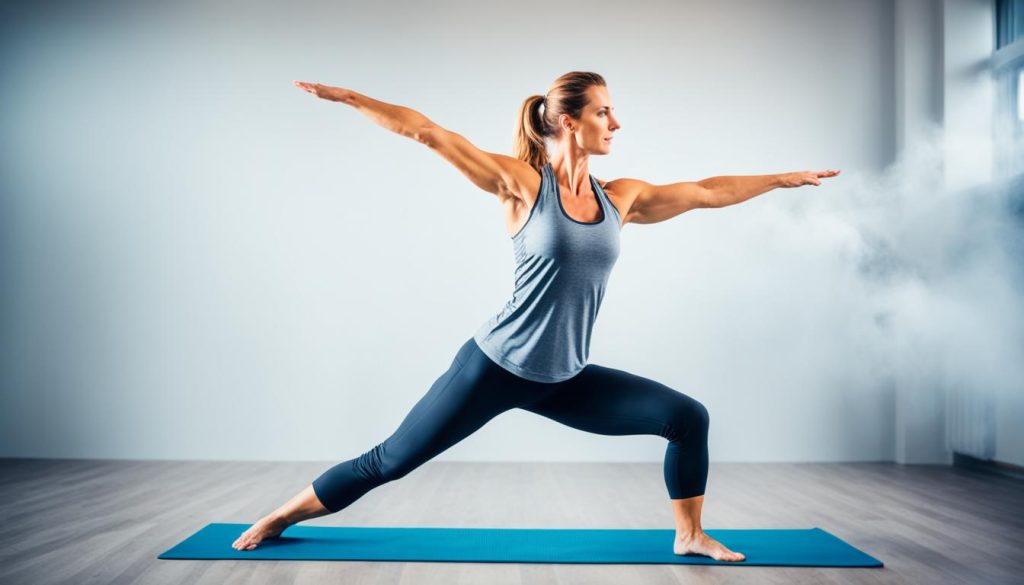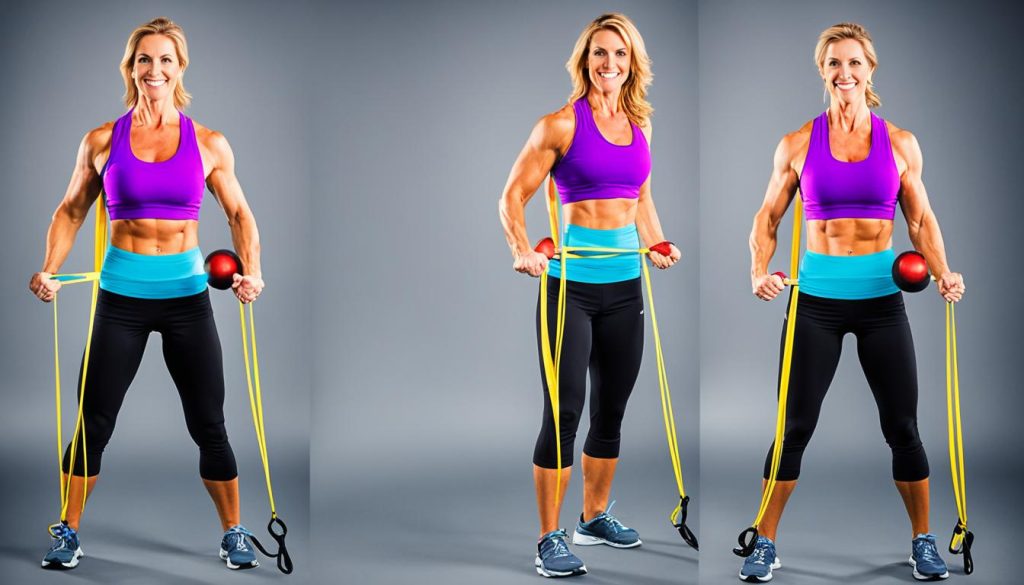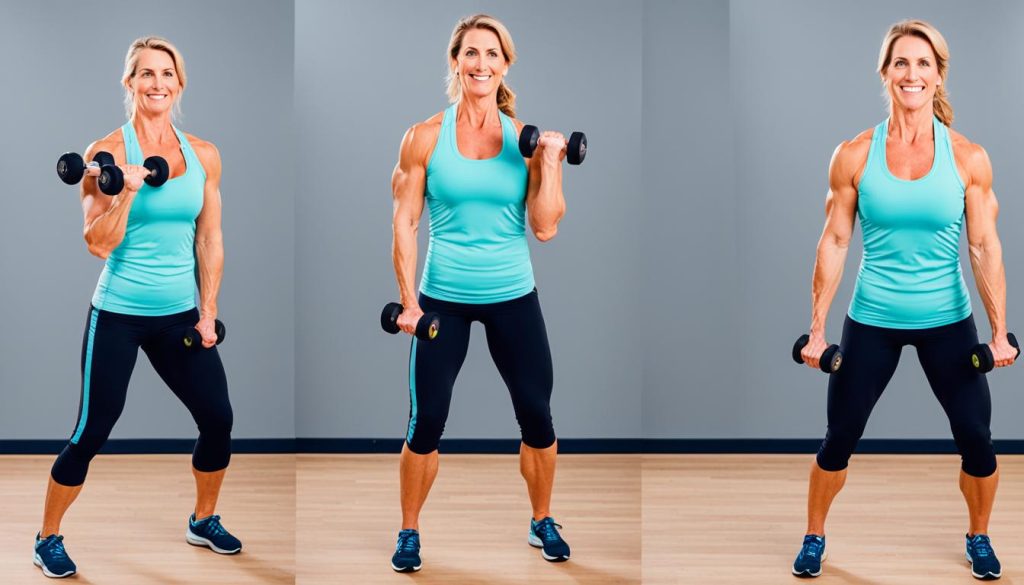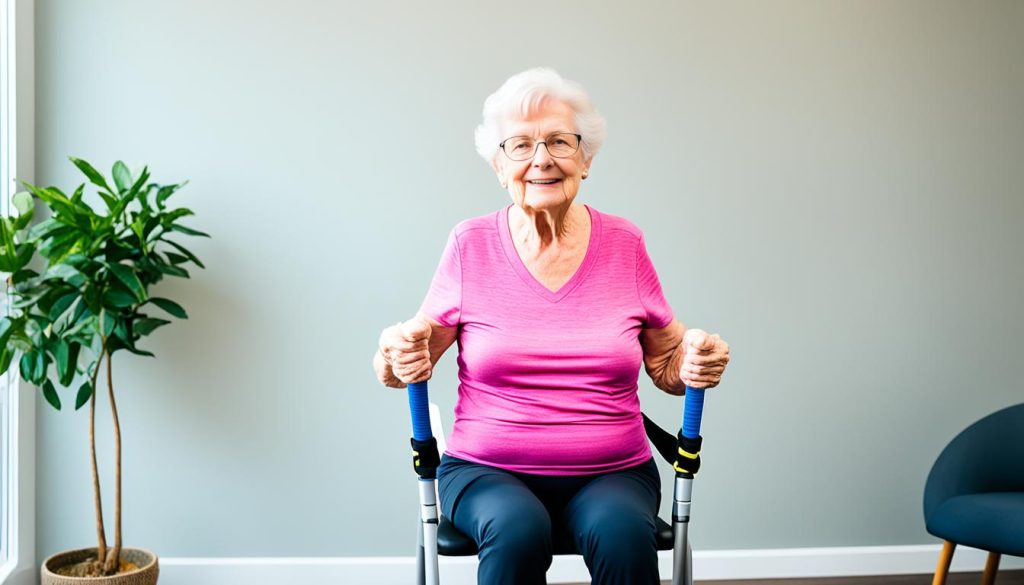Have you ever experienced that frustrating feeling of tightness or pain in your hips? It’s as if your body is begging for a solution, a way to break free from the discomfort and limitations. Well, I was in the exact same boat not too long ago.
In this article, we’ll explore various hip exercises that can help you build stability, improve flexibility, and prevent injuries. From resistance band exercises and weighted moves to specific routines for seniors and individuals with arthritis, we’ve got you covered.
So, are you ready to embark on a journey towards stronger glutes and joints? Let’s dive in!
The Importance of Warmup Exercises
Before starting any hip workout, it’s essential to warm up the large muscles surrounding the hips. This helps to increase circulation and prepare the muscles for more dynamic exercises.
A few effective warmup exercises can be incorporated into your hip workout routine. One such exercise is the Frankenstein walk, which targets the hips, quads, and hamstrings. This exercise involves marching forward while extending one leg and reaching for it with the opposite hand, mimicking Frankenstein’s monster. The Frankenstein walk not only warms up the hip muscles but also engages the core and improves balance.
Another beneficial warmup exercise is the hip circles. This exercise involves standing with feet shoulder-width apart and then slowly rotating the hips in a circular motion. Hip circles improve flexibility and stability in the hip joints, preparing them for the upcoming workout.

These warmup exercises should be performed with proper form and gradually increased in speed and intensity. By incorporating warmup exercises into your hip workout routine, you can maximize the benefits of your workout while reducing the risk of injury.
Hip Workouts with Bands
Resistance bands are a versatile tool that can be incorporated into hip exercises to add resistance and challenge. They are particularly effective for targeting the hip muscles and can help strengthen and tone the hips, thighs, and glutes. Here are two popular exercises that can be performed using resistance bands:
1. Sidestep Exercise
The sidestep exercise with a resistance band is a fantastic way to engage and strengthen the hip muscles. To perform this exercise, place a resistance band just above your knees and stand with your feet hip-width apart. Take a step to the side, stretching the band and feeling the resistance in your hips. Bring the other leg towards the first one, maintaining tension in the band. Repeat this sidestepping movement for several repetitions on each side. To increase the intensity, use a band with more resistance or perform the exercise with a wider step.
2. Clamshell Exercise
The clamshell exercise is another effective hip exercise that can be enhanced using a resistance band. To perform this exercise, lie on your side with your hips and knees slightly bent. Place a resistance band just above your knees. Keeping your feet together, lift your top knee away from the bottom one, like the opening of a clamshell. You should feel the resistance in your hips, thighs, and glutes. Slowly lower your knee back down without letting the band snap together. Repeat this movement for several repetitions on each side. For added difficulty, you can perform variations of the exercise, such as lifting your top leg higher or holding the position for a longer duration.
Remember to maintain proper form and control throughout these exercises. Aim for a slow and controlled movement to fully engage the hip muscles. Resistance bands provide a convenient and accessible way to intensify your hip workouts, making them suitable for individuals of all fitness levels. Give these exercises a try and feel the burn in your hips!

Hip Workouts with Weights
Adding weights to your hip exercises can enhance muscle strength and further challenge your workout routine. Incorporating weighted movements into your hip exercises helps target specific muscle groups and promotes overall stability and core engagement. Two effective exercises that utilize weights are the lateral step-up and single-leg Romanian deadlifts.
1. Lateral Step-Up
The lateral step-up exercise with weights is a great way to work your glutes, quads, hamstrings, and core while promoting balance and stability. To perform this exercise:
- Place a weight on your shoulder or hold dumbbells by your sides.
- Stand next to a step or box with your feet hip-width apart.
- Step onto the box with one foot, ensuring your knee is in line with your ankle.
- Engage your glutes and push through your heel to lift your body onto the box, bringing your opposite knee towards your chest.
- Slowly lower yourself back down, keeping your core engaged and your movements controlled.
- Repeat on the other side.
The lateral step-up exercise targets the gluteus maximus, quads, and hamstrings, helping to build lower body strength and stability. Gradually increase the weight and intensity as you get stronger and more comfortable with the exercise.
2. Single-Leg Romanian Deadlifts
Single-leg Romanian deadlifts with a weight in hand are excellent for improving balance, hip mobility, and core strength. Follow these steps to perform the exercise:
- Stand with your feet hip-width apart, holding a weight in one hand.
- Shift your weight onto one leg while keeping a slight bend in your knee.
- Keep your back straight and hinge forward at the hips, extending your lifted leg backward for balance.
- Lower the weight towards the ground while maintaining a neutral spine and engaging your core.
- Return to the starting position by squeezing your glutes and driving through the heel of your supporting leg.
- Repeat on the other leg.
Single-leg Romanian deadlifts primarily target the glutes and hamstrings, improving hip stability and mobility. Focus on maintaining proper form and gradually increase the weight as your strength and coordination improve.
Adding weights to your hip exercises can help you achieve greater muscle activation and strength in your glutes and hamstrings. Remember to consult a fitness professional if you are new to weightlifting or have any underlying health concerns. Incorporating lateral step-ups and single-leg Romanian deadlifts into your hip workout routine can take your fitness journey to the next level.

Hip Workouts for Seniors
As we age, it’s essential to maintain physical fitness to ensure a healthy and active lifestyle. Hip exercises for seniors can play a crucial role in improving balance, coordination, and movement patterns. These exercises can help prevent falls and injuries, allowing seniors to maintain their independence and quality of life.

One simple yet effective hip exercise for seniors is hip marching. This exercise helps build strength and flexibility in the hips and thighs, promoting greater mobility. To perform hip marching, start by standing with your feet shoulder-width apart. Lift one knee towards your chest while keeping your back straight. Lower the foot back to the ground and repeat with the other leg. Aim for a marching motion, alternating between legs, and gradually increase the speed and range of motion as you feel more comfortable.
Another beneficial hip exercise for seniors is floor hip flexors. This exercise helps stretch the hip flexors, thighs, and glutes, promoting flexibility and reducing tightness in these areas. To perform floor hip flexors, start by lying on your back with your legs extended. Bend one knee and bring it towards your chest, holding onto it with both hands. Gently pull the knee closer to your chest to feel a stretch in your hip and thigh. Hold the stretch for a few seconds and then release. Repeat with the other leg.
It’s important to consult with a healthcare professional or a qualified fitness instructor before starting any new exercise routine, especially if you have specific health conditions or concerns. They can provide guidance and recommend modifications or additional exercises that are most suitable for your needs.
Hip Workouts for Those with Arthritis
Regular stretching exercises can be highly beneficial for individuals with arthritis, helping to improve flexibility and alleviate joint stiffness. Two effective hip exercises for arthritis are the butterfly pose and the knee-to-chest pose.
The butterfly pose is a seated position that gently stretches the hips while also promoting better blood circulation. To perform this pose, sit with your back straight and bring the soles of your feet together, allowing your knees to drop out to the sides. Gently press down on your thighs with your hands, feeling a comfortable stretch in your hip muscles. Hold the pose for 30 seconds to 1 minute, breathing deeply and focusing on relaxation.
The knee-to-chest pose is another great exercise for relieving hip stiffness caused by arthritis. Start by lying on your back with your legs extended. Slowly bring one knee towards your chest, holding onto it with your hands. You should feel a gentle stretch in your hip and lower back. Hold the position for 15-30 seconds, then release and repeat on the other side.
For individuals with arthritis, it is recommended to incorporate these exercises into your daily routine. Stretching daily, even for a short time, can help improve joint mobility and reduce discomfort. Remember to listen to your body and modify the exercises as needed to suit your comfort level.
To visually show you how to perform the butterfly pose and knee-to-chest pose, refer to the image below:
Hip Workouts for Runners
Runners often experience hip pain and tightness due to high-impact movements and overuse. To alleviate these issues and prevent injuries, specific exercises can be incorporated into their fitness routine. Donkey kicks are a powerful exercise that targets the hips and glutes, promoting toning and strength. By lifting one leg to the back in a controlled manner, runners engage the hip muscles and build stability. Side leg raises are another effective exercise, focusing on the glutes and thighs. As runners lift their leg out to the side, they activate and strengthen these important muscle groups.
Adding these hip exercises into a runner’s workout routine can improve flexibility and correct muscle imbalances. By stretching and strengthening tight muscles, runners can enhance their overall performance and reduce the risk of injury. Remember to perform these exercises with proper form and gradually increase intensity over time.
Conclusion
Incorporating hip workouts into your fitness routine is beneficial for people of all ages and fitness levels. By strengthening and stretching the muscles in your hips, you can improve the stability, flexibility, and joint mobility necessary for a healthy and active lifestyle. Whether you’re a weightlifter, runner, senior citizen, or someone looking to improve overall hip health, there are exercises tailored to your needs.
From warmup exercises to exercises with bands and weights, targeting the glutes and hip muscles is key. Specific hip exercises can benefit seniors by improving balance and coordination and preventing falls. Regular stretching exercises can also relieve arthritis. Runners can correct imbalances and prevent injuries with targeted hip exercises.
Remember to start slowly and gradually increase intensity, listening to your body’s needs. If you have any underlying conditions or concerns, it’s always best to consult a healthcare professional. By incorporating regular hip workouts into your routine, you can achieve stronger glutes and joints, enhancing your overall well-being and quality of life. So get started and reap the many benefits of strengthening your hip muscles!
FAQs
Can anyone benefit from hip conditioning exercises?
Yes, everyone can benefit from hip conditioning, even if you don’t have any hip concerns. Stretching and strengthening the muscles in your hips can help build stability and flexibility.
What are the key muscles to target in hip workouts?
The key muscles to target in hip workouts are the gluteus maximus and gluteus medius.
Is it important to warm up before starting a hip workout?
Yes, it’s essential to warm up the large muscles surrounding the hips before starting any hip workout. This helps increase circulation and prepare the muscles for more dynamic exercises.
How can I add resistance and challenge to hip exercises?
Resistance bands can be used to add resistance and challenge to hip exercises. The sidestep exercise with a resistance band and clamshell exercise are effective examples.
Are there specific hip exercises for seniors?
Yes, seniors can benefit from hip exercises to improve balance, coordination, and movement patterns. Hip marching and floor hip flexors are simple exercises that can be beneficial.

